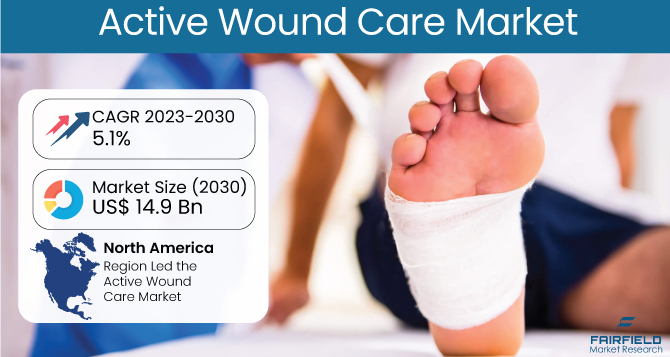The global active wound care market is on a trajectory of remarkable growth, poised to reach a substantial US$14.9 billion by 2030, compared to US$10.5 billion in 2023, exhibiting a robust Compound Annual Growth Rate (CAGR) of 5.1% during the period of 2023-2030. This promising forecast comes on the heels of significant developments and trends reshaping the landscape of wound management.
Continuous Technological Advancements
One notable development in the active wound care industry is the relentless integration of technological advancements. Telemedicine applications, intelligent dressings, and connected devices are revolutionizing wound management, enabling personalized patient care and expediting the healing process through real-time monitoring.
Rise of Bioactive Wound Care Products
A discernible trend in the market is the growing prevalence of bioactive wound care products. Bioactive dressings and topical agents, composed of natural or synthetic compounds, are gaining popularity for their ability to stimulate wound healing, prevent infections, and enhance overall recovery.
Focus on Sustainable Wound Care Practices
There is a significant shift towards sustainable wound care practices, with manufacturers and healthcare providers prioritizing eco-friendly materials and production processes. This reflects a broader commitment to environmental responsibility within the healthcare industry.
Active Adoption of Telemedicine
Telemedicine is increasingly being embraced in wound care, with digital wound assessment tools, virtual consultations, and remote patient monitoring playing a crucial role in optimizing wound care services and improving accessibility, particularly for patients in remote areas.
Skin Substitutes Leading the Market
Skin substitutes are projected to hold the largest market share in 2022, owing to their effectiveness in promoting wound closure, preventing infections, and facilitating tissue regeneration. The rising prevalence of chronic wounds contributes to the expansion of this market segment within the active wound care industry.
Shift Towards Chronic Wound Management
Chronic wounds are anticipated to surpass acute wounds as the dominant market segment in 2022, fueled by prolonged healing periods associated with chronic conditions such as diabetes and an aging population.
Market Dominance of Hospitals
Hospitals are expected to hold the largest market share among healthcare settings, driven by their sophisticated infrastructure and qualified healthcare professionals. However, home healthcare is increasingly being adopted for its practicality and cost-effectiveness.
North America Leading in Market Penetration
North America is poised to have the highest market penetration globally, driven by high levels of awareness, sophisticated healthcare infrastructure, and extensive implementation of active wound care solutions across various applications.
Asia Pacific: Rapid Market Expansion
The Asia Pacific region is anticipated to experience rapid growth in market penetration, fueled by the prevalence of chronic diseases, rising disposable income, and increased healthcare awareness.
Key Growth Determinants
Technological Intervention: Technological advancements, including telemedicine applications and smart dressings, are propelling market growth by enhancing therapeutic results and healthcare efficiency.
Rising Prevalence of Chronic Disorders: The increasing incidence of chronic diseases globally, particularly diabetes and vascular disorders, is driving the demand for active wound care solutions tailored to complex wounds.
Growing Demographic Consumer Base: An aging population globally is contributing to an increased prevalence of chronic wounds, stimulating the demand for specialized wound care products catering to the specific needs of elderly patients.
Major Growth Barriers
Higher Investments: The high cost of sophisticated wound care products poses a significant barrier to market growth, especially in settings with limited resources.
Limited Availability: Restricted reimbursement policies for certain active wound care products hinder their widespread adoption and accessibility, affecting both healthcare providers and patients.
Key Trends and Opportunities
Increased Adoption of Telemedicine: Telemedicine is witnessing widespread adoption, with brands leveraging telemedicine platforms to facilitate remote consultations and real-time wound assessment.
Focus on Environmentally Favourable Solutions: There is a growing demand for sustainable wound care practices, driving the development of environmentally friendly products and manufacturing processes.
Technological Trends Like Smart Dressings: Technological advancements such as intelligent dressings and connected devices are reshaping the wound care industry, with brands investing in research and development to improve product effectiveness and patient outcomes.
Regional Frontrunners
North America: With extensive healthcare spending and advanced technology adoption, North America is set to dominate the global active wound care market.
Asia Pacific: The Asia Pacific region is poised for rapid growth, fueled by increasing healthcare expenditures, an aging population, and advancements in healthcare infrastructure.
Leaders in the Global Active Wound Care Space
Leading companies in the global active wound care market include Smith & Nephew, MiMedx, Tissue Regenix, Organogenesis Inc., Acell Inc., Integra Life Sciences, Solsys Medical, Osiris Therapeutics Inc., Cytori Therapeutics Inc., Human BioSciences, and Wright Medical Group N.V.
Visit our Research Report:https://www.fairfieldmarketresearch.com/report/active-wound-care-market





Comments